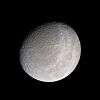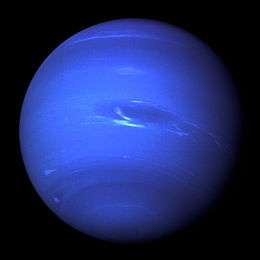Galatea (moon)
|
Galatea as seen by Voyager 2 (elongation is due to smearing) | |
| Discovery | |
|---|---|
| Discovered by | Stephen P. Synnott[1] and Voyager Imaging Team |
| Discovery date | July 1989 |
| Orbital characteristics[2] | |
| Epoch 18 August 1989 | |
| 61 953 ± 1 km | |
| Eccentricity | 0.00004 ± 0.00009 |
| 0.42874431 ± 0.00000001 d | |
| Inclination |
|
| Satellite of | Neptune |
| Physical characteristics | |
| Dimensions | 204×184×144 km (±~10 km)[3][4] |
Mean radius | 88 ± 4 km[5] |
| Volume | ~2.8×106km³ |
| Mass | 2.12 ± 0.08 ×1018 kg[6] |
Mean density | ~0.75 g/cm³ (estimate)[5] |
| ~0.018 m/s2[lower-alpha 1] | |
| ~0.056 km/s[lower-alpha 2] | |
| synchronous | |
| zero | |
| Albedo | 0.08[3][5] |
| Temperature | ~51 K mean (estimate) |
| 21.9[5] | |
Galatea (/ˈɡæləˈtiːə/ GAL-ə-TEE-ə; Greek: Γαλάτεια), also known as Neptune VI, is the fourth closest inner satellite of Neptune. It is named after Galatea, one of the Nereids of Greek legend, whom Cyclops Polyphemus was in love with her.
Galatea was discovered in late July 1989 from the images taken by the Voyager 2 probe. It was given the temporary designation S/1989 N 4[7] The discovery was announced (IAUC 4824) on August 2, 1989, but the text only talks of "10 frames taken over 5 days", giving a discovery date of sometime before July 28. The name was given on 16 September 1991.[8]
It is irregularly shaped and shows no sign of any geological modification. It is likely that it is a rubble pile re-accreted from fragments of Neptune's original satellites, which were smashed up by perturbations from Triton soon after that moon's capture into a very eccentric initial orbit.[9]
Galatea's orbit lies below Neptune's synchronous orbit radius, so it is slowly spiralling inward due to tidal deceleration and may eventually impact Neptune's atmosphere, or break up into a planetary ring upon passing its Roche limit due to tidal stretching.
Galatea appears to be a shepherd moon for the Adams ring that is 1000 km outside its orbit. Resonances with Galatea in the ratio 42:43 are also considered the most likely mechanism for confining the unique ring arcs that exist in this ring.[10] Galatea's mass has been estimated based on the radial perturbations it induces on the ring.[6]
Notes
- ↑ Surface gravity derived from the mass m, the gravitational constant G and the radius r: Gm/r2.
- ↑ Escape velocity derived from the mass m, the gravitational constant G and the radius r: √2Gm/r.
References
- ↑ Planet Neptune Data http://www.princeton.edu/~willman/planetary_systems/Sol/Neptune/
- ↑ Jacobson, R. A.; Owen, W. M., Jr. (2004). "The orbits of the inner Neptunian satellites from Voyager, Earthbased, and Hubble Space Telescope observations". Astronomical Journal. 128 (3): 1412–1417. Bibcode:2004AJ....128.1412J. doi:10.1086/423037.
- 1 2 Karkoschka, Erich (2003). "Sizes, shapes, and albedos of the inner satellites of Neptune". Icarus. 162 (2): 400–407. Bibcode:2003Icar..162..400K. doi:10.1016/S0019-1035(03)00002-2.
- ↑ Williams, Dr. David R. (2008-01-22). "Neptunian Satellite Fact Sheet". NASA (National Space Science Data Center). Retrieved 2008-12-13.
- 1 2 3 4 "Planetary Satellite Physical Parameters". JPL (Solar System Dynamics). 2008-10-24. Retrieved 2008-12-13.
- 1 2 Porco, C.C. (1991). "An Explanation for Neptune's Ring Arcs". Science. 253 (5023): 995–1001. Bibcode:1991Sci...253..995P. doi:10.1126/science.253.5023.995. PMID 17775342.
- ↑ Marsden, Brian G. (August 2, 1989). "Satellites of Neptune". IAU Circular. 4824. Retrieved 2011-10-26.
- ↑ Marsden, Brian G. (September 16, 1991). "Satellites of Saturn and Neptune". IAU Circular. 5347. Retrieved 2011-10-26.
- ↑ Banfield, Don; Murray, Norm (October 1992). "A dynamical history of the inner Neptunian satellites". Icarus. 99 (2): 390–401. Bibcode:1992Icar...99..390B. doi:10.1016/0019-1035(92)90155-Z.
- ↑ Namouni, F.; C. Porco (2002). "The confinement of Neptune's ring arcs by the moon Galatea". Nature. 417 (6884): 45–7. Bibcode:2002Natur.417...45N. doi:10.1038/417045a. PMID 11986660.
External links
| Wikimedia Commons has media related to Galatea (moon). |
- Galatea Profile by NASA's Solar System Exploration
- Neptune's Known Satellites (by Scott S. Sheppard)



